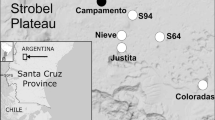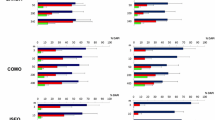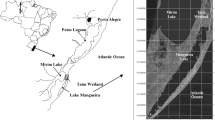Abstract
In this study we analyzed the structure of the microbial planktonic communities in 16 lakes located in one of the Patagonian plateaus. In these environments picoplankton constitute a key component of the food webs. We compared lakes with different regimes (clear vegetated and turbid), in periods with contrasting hydrological conditions. Samplings were conducted during late summer in 2015 (higher water levels), 2016 and 2017 (lower water levels). In each lake we measured limnological variables and quantified picoplankton by flow cytometry. Differences in picoplankton structure among lakes were associated with their regime and hydrological conditions. We found higher abundances of heterotrophic bacterioplankton (HB) in more turbid and eutrophic lakes; these lakes also showed higher abundances of both bacterial fractions analyzed (high and low nucleic-acid content). Clear vegetated oligotrophic lakes showed the lowest photosynthetic picoplankton abundances and higher densities of PE-rich picocyanobacteria (Pcy). All lakes presented PE-rich cells and picoeukaryotes (Peuk), the latter being the most frequent group in all the environments and the most abundant in turbid ones. PC-rich Pcy appeared only in clear vegetated, organic turbid and inorganic turbid, showing one or two cytometric populations. Clear vegetated lakes with water level reduction show an increase of HB, PC-rich cells and Peuk abundances. We provided evidences that picoplankton structure is influenced by lake regime, and in some lakes the shift from clear vegetated to turbid states strongly affects the structure of these communities.









Similar content being viewed by others
References
Agawin NSR, Duarte CM, Agustí S (2000) Nutrient and temperatura control of the contribution of picoplankton to phytoplankton biomass and production. Limnol Oceanogr 45:591–600
Allende L, Tell G, Zagarese HE, Torremorell A, Perez G, Bustingorry J, Escaray R, Izaguirre I (2009) Phytoplankton and primary production in clear-vegetated, inorganic-turbid and algal-turbid shallow lakes from Pampa Plain (Argentina). Hydrobiologia 624:45–60
Anesio AM, Abreu PC, Esteves FA (1997) Influence of the hydrological cycle on the bacterioplankton of an impacted clear water amazonian lake. Microb Ecol 34:66–73
Bell T, Kalff J (2001) The contribution of picophytoplankton in marine and freshwater systems of different trophic status and depth. Limnol Oceanogr 46:1243–1248
Bird DJ, Kalff J (1984) Empirical relationships between bacterial abundance and chlorophyll concentration in fresh and marine waters. Can J Fish Aquat Sci 41:1015–1023
Bouvier T, del Giorgio PA, Gasol JM (2007) A comparative study of the cytometric characteristics of high and low nucleic-acid bacterioplankton cells from different aquatic ecosystems. Environ Microbiol 9:2050–2066
Callieri C (1996) Extinction coefficient of red, green and blue light and its influence on picocyanobacterial types in lakes at different trophic levels. Mem Ist Ital Idrobiol 54:135–142
Callieri C (2008) Picophytoplankton in freshwater ecosystems: the importance of small-sized phototrophs. Freshw Rev 1:1–28
Callieri C (2010) Single cells and microcolonies of fresh-water picocyanobacteria: a common ecology. J Limnol 69:257–277
Callieri C, Stockner JG (2002) Freshwater autotrophic picoplankton: a review. J Limnol 61:1–14
Calvo-Díaz A, Morán XAG, Nogueira E, Bode A, Varela M (2004) Picoplankton community structure along the northern Iberian continental margin in late winter–early spring. J Plankton Res 26:1069–1081
Camacho A, Miracle MR, Vicente E (2003) Which factors determine the abundance and distribution of picocyanobacteria in inland waters? A comparison among different types of lakes and ponds. Arch Hydrobiol 157:321–338
Caron DA, Pick FR, Lean DRS (1985) Chroococcoid cyanobacteria in Lake Ontario: seasonal and vertical distribution during 1982. J Phycol 21:171–175
Carvalho P, Thomaz SM, Bini LM (2003) Effects of water level, abiotic and biotic factors on bacterioplankton abundance in lagoons of a tropical flooplain (Paraná River, Brazil). Hydrobiologia 510:67–74
Cole JJ, Findlay S, Pace ML (1988) Bacterial production in fresh and saltwater ecosystems: a cross-system overview. Mar Ecol Prog Ser 43:1–10
Cotner JB, Biddanda BA (2002) Small players, large role: microbial influence on biogeochemical processes in pelagic aquatic ecosystems. Ecosystems 5:105–121
Craig SR (1987) The distribution and contribution of picoplankton to deep photosynthetic layers in some meromictic lakes. Acta Acad Abo 47:55–81
Fermani P, Torremorell A, Lagomarsino L, Escaray R, Unrein F, Pérez G (2015) Microbial abundance patterns along a transparency gradient suggest a weak coupling between heterotrophic bacteria and flagellates in eutrophic shallow Pampean lakes. Hydrobiologia 752:103–123
Fjeldså J (1986) Feeding ecology and possible life history tactics of the hooded grebe Podiceps Gallardoi. Ardea 74:40–58
Gasol JM, Duarte CM (2000) Comparative analyses in aquatic microbial ecology: how far do they go? FEMS Microbiol Ecol 31:99–106
Gasol JM, Zweifel UL, Peters F, Fuhrman JA, Hagström A (1999) Significance of size and nucleic acid content heterogeneity as measured by flow cytometry in natural planktonic bacteria. Appl Environ Microbiol 65:4475–4483
Izaguirre I, Pizarro H, de Tezanos Pinto P, Rodriguez P, O´Farrel I, Unrein F, Gasol JM (2010) Macrophyte influence on the structure and productivity of photosynthetic picoplankton in wetlands. J Plankton Res 32:221–238
Izaguirre I, Allende L, Escaray R, Bustingorry J, Pérez G, Tell G (2012) Comparison of morpho-functional phytoplankton classifications in human-impacted shallow lakes with different stable states. Hydrobiologia 698:203–216
Izaguirre I, Unrein F, Modenutti B, Allende L (2014) Photosynthetic picoplankton in Argentina lakes. Adv Limnol 65:343–357
Izaguirre I, Lancelotti J, Saad JF, Porcel S, O’Farrell I, Marinone MC, Roesler I, Dieguez MC (2018) Influence of fish introduction and water level decrease on lakes of the arid Patagonian plateaus with importance for biodiversity conservation. Glob Ecol Conserv 14:e00391
Jellett JF, Li WKW, Dickie PM, Boraie A, Kepkay PE (1996) Metabolic activity of bacterioplankton communities assessed by flow cytometry and single carbon substrate utilization. Mar Ecol Prog Ser 136:213–225
Kirk JTO (1994) Light and photosynthesis in aquatic ecosystems. Cambridge University Press, Cambridge
Lancelotti JL (2009) Caracterización limnológica de lagunas de la Provincia de Santa Cruz y efectos de la introducción de trucha arco iris: (Oncorhynchus mykiss) sobre las comunidades receptoras. PhD Thesis, Universidad del Comahue, p 122
Lancelotti JL, Pascual MA, Gagliardini A (2010) A dynamic perspective of shallow lakes of arid Patagonia as habitat for waterbirds. In: Meyer PL (ed) Ponds: formation characteristics and uses. Nova Science Publishers Incorporated, New York, p 208e231
Lancelotti JL, Marinone MC, Roesler I (2016) Rainbow Trout effects on zooplankton in the reproductive area of the critically endangered Hooded Grebe. Aquat Conserv. https://doi.org/10.1002/aqc.2629
Lebaron P, Servais P, Baudoux AC, Bourrain M, Courties C, Parthuisot N (2002) Variations of bacterialspecific activity with cell size and nucleic acid content assessed by flow cytometry. Aquat Microb Ecol 28:131–140
Li WKW (2009) Plankton populations and communities. In: Witman JD, Roy K (eds) Marine macroecology. University of Chicago Press, Chicago, pp 29–64
Li WKW, Jellett JF, Dickie PM (1995) DNA distributions in planktonic bacteria stained with TOTO or TO-PRO. Limnol Oceanogr 40:1485–1495
Liu H, Jing H, Wong TH, Chen B (2014) Co-occurrence of phycocyanin- and phycoerythrin-rich Synechococcus in subtropical estuarine and coastal waters of Hong Kong. Environ Microbiol Repo 6:90–99
Marker AFH, Nusch A, Rai H, Riemann B (1980) The measurement of photosynthetic pigments in freshwater and standardization of methods: conclusions and recommendations. Archiv für Hydrobiologie Beihefte. Ergebnisse der Limnologie 14:91–106
Morán XAG, Bode A, Suárez LA, Nogueira E (2007) Assessing the relevance of nucleic acid content as an indicator of marine bacterial activity. Aquat Microb Ecol 46:141–152
O’Farrell I, Izaguirre I, Chaparro G, Unrein F, Sinistro R, Pizarro H, de Tezanos Pinto P, Lombardo R, Tell G (2011) Water level as the main driver of the alternation between a free-floating plant and a phytoplankton dominated state: a long term study in a floodplain lake. Aquat Sci 73(2):275e287
Olson RJ, Zettler ER, du Rand MD (1993) Phytoplankton analysis using flow cytometry. In: Kemp PF, Sherr BF, Sherr EB, Cole JJ (eds) Handbook of methods in aquatic microbial ecology. Lewis Publishers, Boca Raton, pp 175–186
Panza JL, Franchi MR (2002) Magmatismo Bas_altico Cenozoico Extrandino. In: Haller MJ (ed) Geología y Recursos Naturales de Santa Cruz. Relatorio del XV Congreso Geol_ogico Argentino, El Calafate, p 201e236
Pereyra FX, Fauqué L, González Díaz EF (2002) Geomorfología. In: Haller MJ (ed) Geología y Recursos Naturales de Santa Cruz. Relatorio del XV Congreso Geológico Argentino, El Calafate, pp 325–352
Pérez GL, Torremorell A, Bustingorry J, Escaray R, Pérez P, Diéguez M, Zagarese H (2010) Optical characteristics of shallow lakes from the Pampa and Patagonia regions of Argentina. Limnolog Ecol Manag Inland Waters 40:30–39
Pick FR, Agbeti DM (1991) The seasonal dynamic and composition of photosynthetic picoplankton communities in temperate lakes in Ontario, Canada. Int Rev Gesamten Hydrobiol 76:565–580
Quiros R, Renella AM, Boveri MB, Rosso JJ, Sosnovsky A (2002) Factores que afectan la estructura y funcionamiento de las lagunas pampeanas. Ecol Austral 12:175–185
Richardson TL, Jackson GA (2007) Small phytoplankton and carbon export from the surface ocean. Science 315:838–840
Roesler I (2016) Conservación del Macá Tobiano (Podiceps gallardoi): factores que afectan la viabilidad de sus poblaciones. PhD Thesis. Universidad de Buenos Aires, Buenos Aires
Roesler I, Imberti S, Casañas H, Mahler B, Reboreda JC (2012) Hooded Grebe Podiceps gallardoi population decreased by eighty per cent in the last twenty-five years. Bird Conserv Int 22:371e382
Saad JF, Porcel S, Lancelotti J, O’Farrell I, Izaguirre I (2018) Both lake regime and fish introduction shape autotrophic planktonic communities of lakes from the Patagonian Plateau (Argentina). Hydrobiologia. https://doi.org/10.1007/s10750-018-3660-6
Sanchez ML, Lagomarsino L, Allende L, Izaguirre I (2015) Changes in the phytoplankton structure in a Pampean shallow lake in the transition from a clear to a turbid regime. Hydrobiologia 752:65e76
Sánchez M, Pizarro H, Tell G, Izaguirre I (2010) Relative importance of periphyton and phytoplankton in turbid and clear vegetated shallow lakes from the Pampa Plain (Argentina): a comparative experimental study. Hydrobiologia 646:271–281
Scheffer M, Carpenter SR (2003) Catastrophic regime shifts in ecosystems: linking theory to observation. Trends Ecol Evol 18:648–656
Scheffer M, van Nes EH (2007) Shallow lakes theory revisited: various alternative regimes driven by climate, nutrients, depth and lake size. Hydrobiologia 584:455–466
Scheffer M, Bascompte J, Brock WA, Brovkin V, Carpenter SR, Dakos V, Held H, Van Nes EH, Rietkerk M, Sugihara G (2009) Early-warning signals for critical transitions. Nature 461(7260):53–59
Schiaffino MR, Gasol JM, Izaguirre I, Unrein F (2013) Picoplankton abundance and cytometric group diversity along a trophic and latitudinal lake gradient. Aquat Microb Ecol 68:231–250
Sharp JH, Peltzer ET, Alperin MJ, Cauwet G, Farrington JW, Fry B, Karl DM, Martin JH, Spitzy A, Tugrul S, Carlson CA (1993) Procedures subgroup report. Mar Chem 41:37–49
Sherr EB, Sherr BF (2002) Significance of predation by protists in aquatic microbial food webs. Anton Leeuw Int J G 81:293–308
Somogyi B, Felföldi T, Dinka M, Vörös L (2010) Periodic picophytoplankton predominance in a large, shallow alkaline lake (Lake Ferto/Neusiedlersee). Ann Limnol Int J 1051:9–19
Søndergaard M (1991) Phototrophic picoplancton in temperate lakes: seasonal abundance and importance along a trophic gradient. Int Rev Gesamten Hydrobiol 76:505–522
Stockner JG (1988) Phototrophic picoplankton: an overview from marine and freshwater ecosystems. Limnol Oceanogr 33:765–775
Stockner JG (1991) Autotrophic picoplankton in freshwater ecosystems: the view from the summit. Int Rev Gesamten Hydrobiol 76:483–492
Stockner JG, Antia NJ (1986) Algal picoplankton from marine and freshwater ecosystems: a multidisciplinary perspective. Can J Fish Aquat Sci 43:2472–2503
Stomp M, Huisman J, Vörös L, Pick FR, Laamanen M, Haverkamp T, Stal LJ (2007) Colorful coexistence of red and green picocyanobacteria in lakes and seas. Ecol Lett 10:290–298
R Core Team (2016) R: a language and environment for statistical computing. R Foundation for Statistical Computing, Vienna, Austria. https://www.Rproject.org/. Accessed 2018
Torremorell A, Pérez G, Lagomarsino L, Huber P, Queimaliños CP, Bustingorry J, Fermani P, Llames ME, Unrein F (2014) Microbial pelagic metabolism and CDOM characterization in a phytoplankton-dominated versus a macrophytedominated shallow lake. Hydrobiologia. https://doi.org/10.1007/s10750-014-2057-4
Valderrama JC (1981) The simultaneous analysis of total nitrogen and total phosphorus in natural waters. Mar Chem 10:109e122
Vörös L, Callieri C, Balogh KV, Bertoni R (1998) Freshwater picocyanobacteria along a trophic gradient and light quality range. Hydrobiologia 369(370):117–125
Vörös L, Mozés A, Somogyi B (2009) A five-year study of autotrophic winter picoplankton in Lake Alaton, Hungary. Aquat Ecol 43:727–734
Watson SB, Kling H (2017) Lake of the Woods phyto- and picoplankton: spatiotemporal patterns in blooms, community composition, and nutrient status. Lake Reserv Manag. https://doi.org/10.1080/10402381.2017.1331282
Acknowledgements
This investigation was financed by the following Grants: FONCYT PICT 2013-0794 of the Argentinean Funds for Scientific and Technical Investigations of Argentina and Proyecto Macá Tobiano. We thank the logistic support and the facilities provided by the National Park “Parque Nacional Patagonia” in the Buenos Aires Plateau. We thank the collaboration of Dr. J. Lancelotti, Dr. I. O´Farrell, Dr. M. C Dieguez, Lic. M. C. Marinone, Virginia Rago and the volunteers of the Proyecto Macá Tobiano during the 2015, 2016 and 2017 field trips in the Buenos Aires Plateau.
Author information
Authors and Affiliations
Corresponding author
Additional information
Publisher's Note
Springer Nature remains neutral with regard to jurisdictional claims in published maps and institutional affiliations.
Electronic supplementary material
Below is the link to the electronic supplementary material.
Rights and permissions
About this article
Cite this article
Porcel, S., Saad, J.F., Sabio y García, C.A. et al. Microbial planktonic communities in lakes from a Patagonian basaltic plateau: influence of the water level decrease. Aquat Sci 81, 51 (2019). https://doi.org/10.1007/s00027-019-0647-y
Received:
Accepted:
Published:
DOI: https://doi.org/10.1007/s00027-019-0647-y




